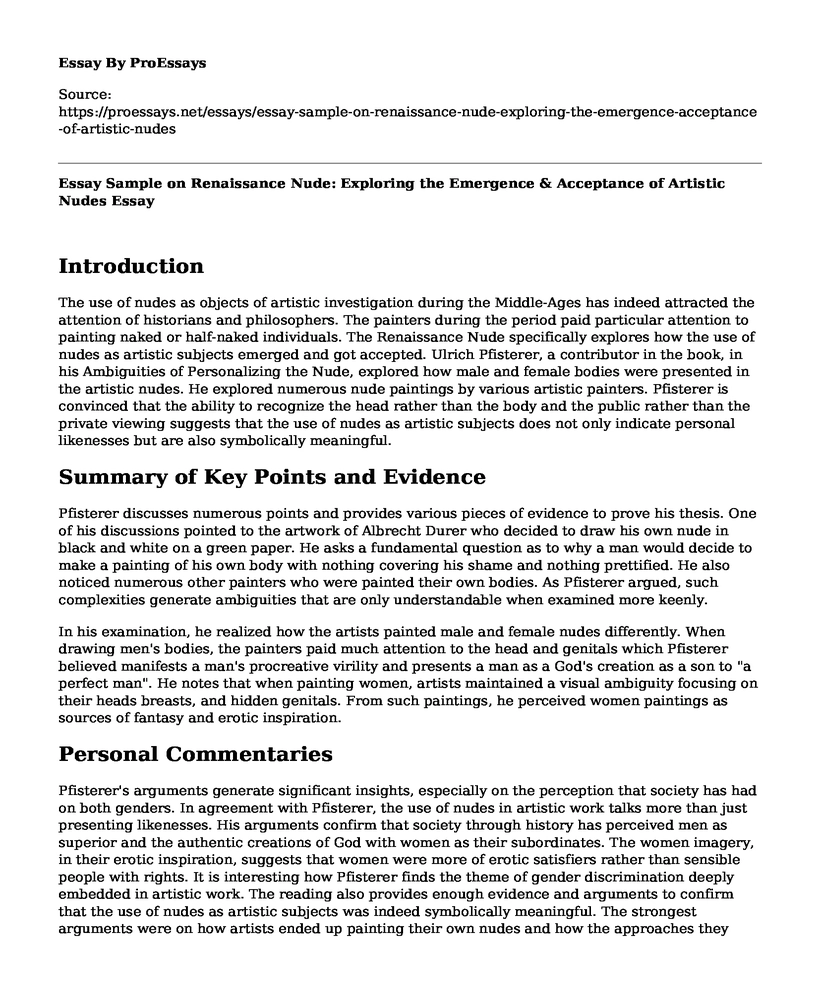Introduction
The use of nudes as objects of artistic investigation during the Middle-Ages has indeed attracted the attention of historians and philosophers. The painters during the period paid particular attention to painting naked or half-naked individuals. The Renaissance Nude specifically explores how the use of nudes as artistic subjects emerged and got accepted. Ulrich Pfisterer, a contributor in the book, in his Ambiguities of Personalizing the Nude, explored how male and female bodies were presented in the artistic nudes. He explored numerous nude paintings by various artistic painters. Pfisterer is convinced that the ability to recognize the head rather than the body and the public rather than the private viewing suggests that the use of nudes as artistic subjects does not only indicate personal likenesses but are also symbolically meaningful.
Summary of Key Points and Evidence
Pfisterer discusses numerous points and provides various pieces of evidence to prove his thesis. One of his discussions pointed to the artwork of Albrecht Durer who decided to draw his own nude in black and white on a green paper. He asks a fundamental question as to why a man would decide to make a painting of his own body with nothing covering his shame and nothing prettified. He also noticed numerous other painters who were painted their own bodies. As Pfisterer argued, such complexities generate ambiguities that are only understandable when examined more keenly.
In his examination, he realized how the artists painted male and female nudes differently. When drawing men's bodies, the painters paid much attention to the head and genitals which Pfisterer believed manifests a man's procreative virility and presents a man as a God's creation as a son to "a perfect man". He notes that when painting women, artists maintained a visual ambiguity focusing on their heads breasts, and hidden genitals. From such paintings, he perceived women paintings as sources of fantasy and erotic inspiration.
Personal Commentaries
Pfisterer's arguments generate significant insights, especially on the perception that society has had on both genders. In agreement with Pfisterer, the use of nudes in artistic work talks more than just presenting likenesses. His arguments confirm that society through history has perceived men as superior and the authentic creations of God with women as their subordinates. The women imagery, in their erotic inspiration, suggests that women were more of erotic satisfiers rather than sensible people with rights. It is interesting how Pfisterer finds the theme of gender discrimination deeply embedded in artistic work. The reading also provides enough evidence and arguments to confirm that the use of nudes as artistic subjects was indeed symbolically meaningful. The strongest arguments were on how artists ended up painting their own nudes and how the approaches they used to draw men and women quite differently.
Conclusion
It is indeed evident from the analysis that prints, drawings, and paintings by the masters of Renaissance were more than just their face value and had hidden and shocking meanings that revealed public beliefs. The Renaissance Art analyzed by Pfisterer points to a complex ambiguity in how the artists used nudes to presents the bodies of others as well as their bodies and how gender disparities are deeply embedded in the art. The analysis generates insight into Renaissance art as not only as mere presentations of people but also as presentations of culture.
Bibliography
Pfisterer, Ulrich. ""Here's Looking at You": Ambiguities of Personalizing the Nude." In The Renaissance Nude, 307-323. Los Angeles: Getty Publications, 2018.
Cite this page
Essay Sample on Renaissance Nude: Exploring the Emergence & Acceptance of Artistic Nudes. (2023, Mar 14). Retrieved from https://proessays.net/essays/essay-sample-on-renaissance-nude-exploring-the-emergence-acceptance-of-artistic-nudes
If you are the original author of this essay and no longer wish to have it published on the ProEssays website, please click below to request its removal:
- A Spirit Reborn
- Historical Essay Example: The Rise and Fall of The Roman Empire
- Monomyth in Star Wars a New Hope Essay
- The Perils of Indifference Essay Example
- Essay Example on Vivid Tones and Sacrifice in Helmet for My Pillow
- Research Paper on U.S. Loses to Vietnam: Reasons Behind the Historic Defeat
- Representation of LGBT in Arab Cinema - Essay Sample







